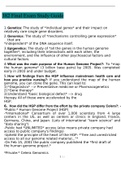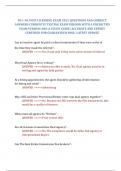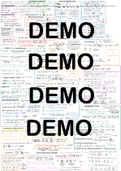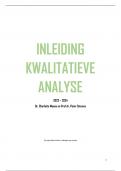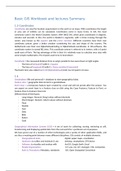Aggregate demand is total spending in the economy, or actual GDP. Spending is undertaken by household, firms, governments or
foreigners.
Components of aggregate demand:
- C (household spending (55%)
- I (gross fixed capital spending (20%)
- G (government consumption) (30%)
- X (exports of goods and services) - M (imports of goods and services) (-5%)
AD = C + I + G + (X-M)
The AD curve is downwards sloping with respect to price level. A change in any of the components of AD leads to a shift in AD.
Increase in interest rates Rise in average household income during a boom
÷
÷
iii.
.
Short run aggregate supply shows how much output the economy can generate in the short term at each price level. Shifts in SRAS
are caused by changes in input costs.
Rise in the price of oil Fall in the minimum wage
"
Long run aggregate supply shows the productive capacity of an economy in the long run.
Classical economists believe that the LRAS is vertical because all FOPs are fully employed in the long run. They believe that labour
markets clear, and therefore that unemployment will not persist.
Keynesian economists state that unemployment can persist in the long run, and point to empirical evidence (e.g. 1930s mass
unemployment in the US) to support their case. They state that labour markets do not always clear, due to factors such as minimum
wage and TU power, which prevent wages falling to market clearing level, hence wages are ‘downwardly sticky’. They also point to
structural and frictional unemployment.
Shifts in the LRAS are caused by a change in productive capacity, due to an increase or decrease in the quantity or quality of FOPs.
E.g. technology, productivity, participation rates, factor mobility, entrepreneurial activity. Govt. policy which attempts to shift LRAS
outwards is called supply-side policy.
µ lmonetarypowy
)
Classical: effect of HS2
µ ( SSP ) Keynesian: effect of interest rates cut and multiplier
KeiI
" "
EÉ!
"
" ""
,NATIONAL INCOME
National income = National output = national expenditure
Output: total amount of goods and services produced in one year.
Expenditure: total amount of domestic spending.
Income: total incomes earned by FOPs involved in the productions of goods and services in one year.
The key measure of this in the UK is Gross Domestic Product.
GDP = value of goods and services which an economy produces over any time period, usually a year.
CIRCULAR FLOW OF INCOME
The circular flow of income model is a simple model of the economy showing flows or money and goods and services.
Mine
FIRM
} §Ü
ent
§
§ 3
BANNS GNENNMENT
÷
MMMMM
Injections: exports, investment, govt.spending.
Withdrawals: imports, savings, taxes.
Ceteris paribus, when injections > withdrawals, NI rises and when withdrawals > injections, NI falls.
THE MULTIPLIER EFFECT
The multiplier effect is a theory by John Maynard Keynes which states that when there is an injection (upward multiplier) or withdrawal
(downwards multiplier) into the circular flow of income, there is a more than proportionate change in national income. An initial injection
will create employment opportunities which raise national income, this creates extra demand for goods and services which creates
further employment opportunities.
The multiplier is the value by which the initial injection / withdrawal is multiplied to calculate the final change in national income.
Demonstrating the multiplier
' Mtartottwomrrurm investment
MOUSTMRNDS ✓
¢Ü÷!
MAC
'
0.9
Asswmvng
.
siiiii:*
FIRMS
Value of multiplier = 1/1-MPC = 1/MPW = 1/MPS+MPT+MPM
Using the multiplier:
- Comment on the extent of impact of injections / withdrawals
- Comment on how the value of the multiplier changes during recessions / booms, which may add to, or detract from, the
argument in favour of expansionary fiscal policy. E.g. during a recession, the savings ratio rises, which weakens the multiplier
and therefore the argument in favour of a Keynesian fiscal stimulus is weakened.
, INDEX NUMBERS
To assess a change in any macroeconomic variable, index numbers are often used.
The base year (starting point of reference) is always 100 and the index number is then expressed as 100 times the ratio to the base
value.
new−old
% change = new
x 100
Year Nominal GDP (£) Index number Change in GDP from Index number Inflation rate Real GDP
for GDP previous year for inflation growth
2009 500bn 100 100
2010 550bn 110 10% 112 12% -2%
2011 600bn 120 9% 120 7% 2%
2012 630bn 126 5% 122 1.7% 3.3%
ECONOMIC GROWTH
MEASURES OF GROWTH
GDP = TOTAL VALUE OF GOODS AND SERVICES PRODUCED IN THE ECONOMY. Measured by tax receipts and business /
government surveys.
- Nominal GDP growth refers to the money value increase in the value of goods and services in the economy.
- Real GDP growth refers to an increase in the volume of goods and services produced. Therefore it measures the increase in
output of an economy adjusted for inflation.
- In recent years, nominal UK incomes have been rising which would indicate that living standards have risen, but in reality,
price level has risen faster.
- GNI is the GDP + net income from abroad.
GDP per capita can be used to give an indication of a country’s standard of living.
- Quality of goods and services?
- Income inequality? E.g. Qatar vs Sweden
- Differences in price levels
- Unofficial work not measured
- Other factors directed towards QOL e.g. environment and political freedoms
HDI includes a number of measures in addition to GDP per capita including:
- Literacy rates
- Average number of years in school
- Life expectancy
Purchasing Power Parity is used in comparison of living standards with different currencies. Purchasing power is the real value of an
amount of money in terms of what you can buy with it.
ACTUAL OR SHORT RUN GROWTH
A rise in the total value of goods and services produced in the economy, measured by Real GDP. There is no change in the
productive potential of the economy.
Actual growth PPF Actual growth SRAS Actual growth AD
" PL
° SRAS ,
it O
-
s
I
I
,
→
I
'
Sr S
I
ti
→
I
"
r
i
: I
l
YI
I
l
YL RNO
→




